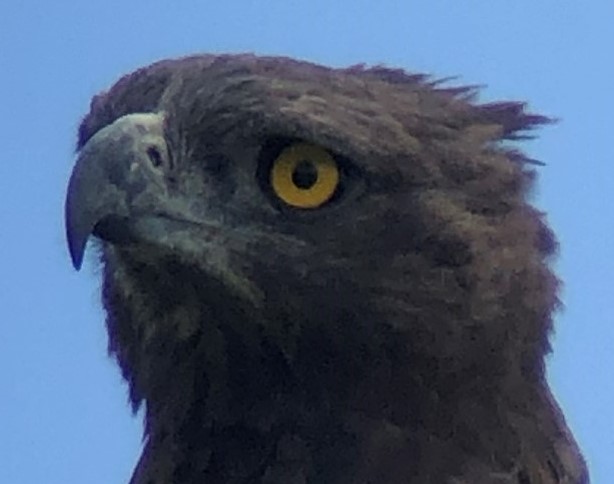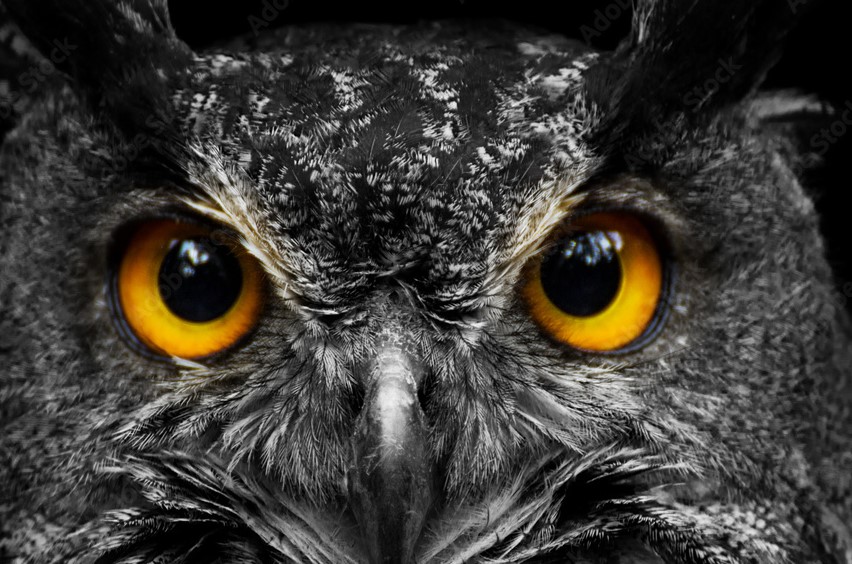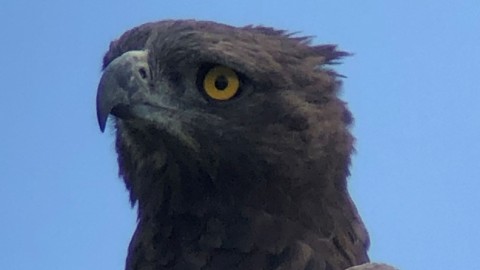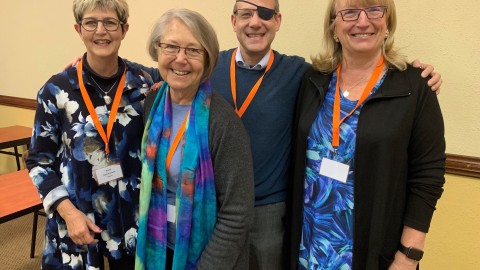Leoni Joubert (M.Phil (Optom) (RAU); B.Optom; MBCO(UK); CAS (NECO-USA); CAS (BV and Paeds NECO-USA); Cert Dyslexia (UJ))
Have you ever wondered how animals see the world? We always tend to see things from a human perspective and often incorrectly assume how animals see. This very brief foray into the world of animal vision will attempt to shed some light (pardon the pun) on this profoundly complex and interesting topic.
I shall assume that most people know the basic structure of a human eye and how it works. Most mammal eyes have a similar structure to a human eye but with very different abilities. Our world is a colourful one and humans (having three colour vision receptors in their retinas just like other primates) can perceive an amazing variety of colours. But we pale in comparison to the range of colour that birds can see. Even a lowly dove can see more than a million hues of colour, thanks to their retinas containing not three but four colour vision receptors! Some birds can also see in Ultra-Violet (UV), an ability makes their world much more vibrant than we can ever imagine.
We’ve all heard of having “Eagle Vision”,
but do we really know
what that means?

Raptors, like the eagles, have amazing vision. They have an area on their retinas (the nerve layer at the back of the eye) that can magnify their vision, giving them the ability to see things much further than we can (sort of like having a built-in telescope!). Owls can see really well at night and have huge eyes in relation to their heads.
So huge, in fact, that there is no room for eye muscles to move the eye and therefore owls’ eyes do not move at all. This is why owls have the ability to turn their heads almost completely around, thereby compensating for their inability to move their eyes. Birds and some other animals have a third eyelid (nictitating membrane) that helps to moisten and protect the eye.
Imagine trying to keep your eyes open while sticking your head out of a vehicle traveling at high speed and you can then comprehend how this membrane would work almost like a pair of goggles to protect the eye from watering too much as well as from airborne particles (for example, a falcon that can fly up to 300km/h when diving for prey!). An ostrich has the largest eye of any land animal, even bigger than an elephant’s eye.
An ostrich has the largest
eye of any land animal,
even bigger than an
elephant’s eye.
In fact, each of its eyes is bigger
than its brain.
Speaking of elephants, did you know that an elephant’s eye is the same size as a human’s? The visual system of an elephant is very similar to ours, they see almost the same as we do in terms of colour and have similar night vision ability.
The other interesting fact about elephants is that they have no tear glands (so they cannot cry). Instead elephants possess a Harderian gland that secretes a lubricating substance that is smeared across the eye using their nictitating membrane (which we do not have). This leads to them often having a white frothy substance in the corner of their eyes. If you see this it is completely normal so don’t think the poor ellie has an eye infection. Elephants also have very long eye lashes to protect their eyes from both the sun and dust.

Unlike birds or primates (including humans), most other mammals do not have such good colour vision. Animals like cats, dogs, lions, leopards, antelope and giraffe all only have two colour vision receptors and see the world in hues of green and blue because they are missing a red colour receptor in their retinas. They cannot perceive red at all. This is why hunters can wear a bright red/orange jacket and be less visible to deer. We can see the bright warning red colour but to an antelope (or dog or cat or lion) it will just appear as a muted shade of greenish-blue.
To us a tiger is obviously visible but to the prey that it is stalking it can easily blend in to the dappled background of a forest and be almost invisible (unless it moves). Of course animals that hunt at night can see much better than we can in the dark.
Lions have terrific night vision to assist them when hunting at night. The retina of a lion has many more rods (used for seeing at night and for detecting movement) than cones (used for colour vision and fine detail). It is much more important for a lion to be able to see well in low light than to see in colour, so this adaptation makes perfect sense.
They also have a special coating at the back of the eye called a tapetum lucidum which is able to reflect even moonlight, making their eyes appear to glow in the dark. The tapetum lucidem (it literally translates as “light carpet”) intensifies objects and makes their eyes more light sensitive under low light conditions. This coating gives lions eight times better sight than a human at night. Lions also have a third eyelid, which can be drawn over to clean and protect the eye. Lions have round pupils instead of vertical slits, as are found in domestic cats. Lion cubs are born with blue eyes that change to amber or brown when aged two to three months.

People often say that they can tell whether an animal is a predator or prey by looking at the colour of the reflection of light from their eyes at night and that predators have a red reflection and antelope for example have a green eye reflection. The colour of the reflection has nothing to do with whether they are a predator or not! In fact the colour that is seen is dependent on the angle of the eye when the light is reflected as well as the type of light entering the eyes. So you can see a lion’s eyes reflecting green or red depending on the eye position.
A much better method to determine whether an animal is a predator or not is to look at the position of their eyes. Predators have eyes that both point forward and give them improved binocular vision that enables them to accurately judge the position and distance of their prey.
Animals that are preyed upon (such as zebra for example), have eyes that are positioned on the side of their heads and that give them a bigger field of view which enables them to see a potential threat, especially from behind.

The pupil is the small black opening in the eye that lets light through to the retina. It can be widened or narrowed to let in more or less light as needed. Our pupils are round but many animals have different pupil shapes.
Cats have vertical slit-like pupils that can dramatically open and close to allow much more light to enter during low-light conditions. Antelopes and the like have horizontal pupils that enable them to allow more light to enter on a horizontal plane which together with their side-mounted eyes, assist them in seeing more acutely horizontally.
Geckos have an array of pupils that are positioned vertically and they can open them the widest of any animal. This gives the gecko exceptional night vision. A gecko’s eyes also have many more light-sensitive cells than human eyes, giving the animal the ability to detect objects and even to see colours at night.
To give you an idea of the gecko’s amazing night vision, let us just say that, while cats and sharks can see six and ten times better than humans at night, respectively, the Leaf Tailed gecko and other nocturnal gecko species can see up to 350 times better than we can in dim light! Geckos and lizards don’t have eyelids. Their eyes are protected by a transparent membrane and geckos are often seen cleaning this membrane with their tongue.

Some animals have unique adaptations
to their eyes. The dassie for example is
able to look directly into the sun
without damaging their eyes. Humans
would blind themselves if we did that,
but the dassie uses this to help them
look for eagles that prey on them.
Invertebrates (insects, spiders, and others) have very different eyes to humans. They have compound eyes of many different types. In fact, there are 10 different types of eyes of which simple eyes (like humans and other mammals possess) are just one. Some invertebrate animals like scorpions can even see in UV.
The carapace of a scorpion glows under UV light and since they can see UV, it allows them to find each other for mating purposes. Other invertebrates for example dung beetles, are able to perceive polarized light which is important for them in terms of navigation.

Dragonflies’ eyes are so big that they cover almost the entire head, giving it a helmeted appearance. These eyes can have up to 30,000 small ommatidia, each one containing a lens and a series of light-sensitive cells. Their eyesight is superb; they can detect colours and polarized light, and are particularly sensitive to movement, allowing them to quickly discover any potential prey or enemy. They have a horizontal array of super-sensitive photoreceptors that form a “horizon view”. Males often have a “love spot” in their eyes for viewing upwards that helps them find a mate.
Spiders are popularly known for having many eyes (although this varies greatly among the different species, with some having two, four, six, or eight eyes). Some eyes are used for detecting movement while others are used for seeing detail.
Can you guess which animal on Earth
has the largest eye? It is a giant squid
with eyes as large as soccer balls!
What about the animal with the most complex eyes on earth? As you’ve probably guessed by now it is not humans. That honour belongs to the mantis shrimp that has eyes that have 12 colour receptors (compared to our paltry 3!), can also see in UV and polarized light, can move its eyes independently and perceive depth in one eye only.
Although this brief article has barely scratched the surface of the fascinating world of animal vision I hope you are as amazed as I am!



